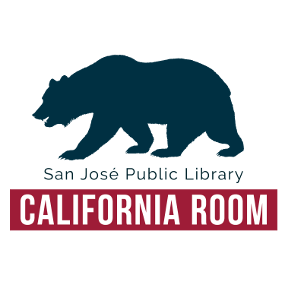Originally written by Estella Inda.
American Archives Month: October
October is American Archives Month. This year we are focusing on Local Landscape Artists whose work can be found in our local archives. Here are just a few of those artists.
Charles Henry Harmon
(December 23, 1859 – October 14, 1936)
Harmon had no formal training or schooling in art, which led to his unorthodox methods and unique technique. In 1883, he began focusing on landscapes of Santa Clara Valley and Monterey Peninsula where he painted many coastal scenes. Harmon received recognition from Paris when a French critic visited the Pacific Coast and was profoundly impressed by his work.
In 1915, the County Board of Supervisors commissioned Harmon to paint the large canvas "East Santa Clara Valley at Blossom Time" for the San Francisco World’s Fair. More about Harmon and his work can be found in the archives at History San José.
Andrew Putnam Hill
(August 9, 1853 – September 4, 1922)
Hill studied at the California School of Design in San Francisco. Hill was commissioned to paint prized animals, including the Stanford’s Family dog Tootsie in 1889. Hill’s landscape art provided a visual record of the Santa Clara Valley. Hill is best remembered for founding the Sempervirens Club in 1900, which was responsible for creating Big Basin Redwoods California State Park in 1901.
While he was commissioned to take photographs of redwood trees he discovered that the property owner planned to cut down all of his trees. Hill argued that private property rights should not supersede the rights of generations of Californians who would be deprived of experiencing the majestic redwoods. In 1923, a monument to him was placed in the park with the inscription, "He Saved the Redwoods". More about Hill’s early environmentalist work, his house (moved in 1997 from original location of 1350 Sherman Street, San José, California), and his work can be found in the archives at History San José.
Astley David Montague Cooper
(December 23, 1856 – September 10, 1924)
In 1883, Cooper bought his house that he lived in for 41 years on 250 Clay Street (now South 19th Street). A few blocks up in 1904, on the corner of 21st Street and San Antonio Street, Cooper built his art studio, which became an instant landmark in San José. The studio was designed in—what was considered bizarre for its time—Egyptian-style architecture. It often drew a number of tourists to its doors. It was said that his studio was literally a maze of paintings of every kind and the ceilings and walls were adorned with a myriad of fascinating odds and ends. Cooper’s unique studio was destroyed in the 1950s.
It was estimated that Cooper completed more than 1,000 paintings in his lifetime, a portion of which he gave away to support his unconventional lifestyle. More about Cooper and his work can be found in the archives at History San José.
Ernest Pierre de Saisset
(1864 – December 4, 1899)
San José native, de Saisset attended Santa Clara College where he studied oil painting. Unable to find someone local to teach him professionally, his father agreed to send him to France to study. Once in Paris, de Saisset was able to study under a number of masters, one of which was Adolphe William Bouguereau. It was said that he was kicked out of art school because of his use of rough language. In 1895, de Saisset returned to San José and set up a studio in the family home on South Market (now The Tech Museum of Innovation).
De Saisset died four years later of rheumatism. On April 22, 1950 de Saisset’s youngest sister Isabel passed away, in her will she bequeathed two parcels of real estate located in downtown San José to Santa Clara University. She stipulated that the land should be sold and the proceeds used to build and sustain a museum in honor of her oldest brother, and former Santa Clara student. The de Saisset Art Gallery and Museum was established at the University of Santa Clara in 1955. More about de Saisset and his work can be found in the archives at de Saisset Museum.
Francis Harvey Cutting
(October 8, 1872 – June 8, 1964)
Cutting attended San José State College and then taught school for a short while. An inheritance from an uncle allowed Cutting to quit his day job and dedicate himself to painting. In the 1920’s, Cutting had a studio in Pacific Grove where he studied art with other artists such as William Adam, Arthur Hill Gilbert, Charles Harmon, and Frank Pebbles.
In 1927, Cutting built his studio and home in Campbell at 125 Harrison Avenue and remained there until his death. More about Cutting and his work can be found in the archives at Campbell Historical Museum and Ainsley House.
Edith Harvey Heron
(January 2, 1895 – March 6, 1980)
In the 1920s, Heron,a San José native, taught art at the Stockton State Hospital, the method of with which she was teaching became known as “art therapy”. In the summer of 1932, while trying to paint the Carmel Mission there was some confusion about her having permission to be on the grounds and paint. Since Heron refused to leave, a police officer was called to force her to go. As a result of this incident all artists were banned.
In 1968, Heron continued her art therapy by teaching arts and crafts to Japanese-Americans at internment camps at Poston War Relocation Center in Arizona. More about Heron and her work can be found in the archives at San José Public Library – California Room and San José State University – Special Collections.
Heron’s work is now on display at San José Public Library – California Room.

Learn More
Learn ore about Local Artist in the Archives:






Add a comment to: Artist in the Archives